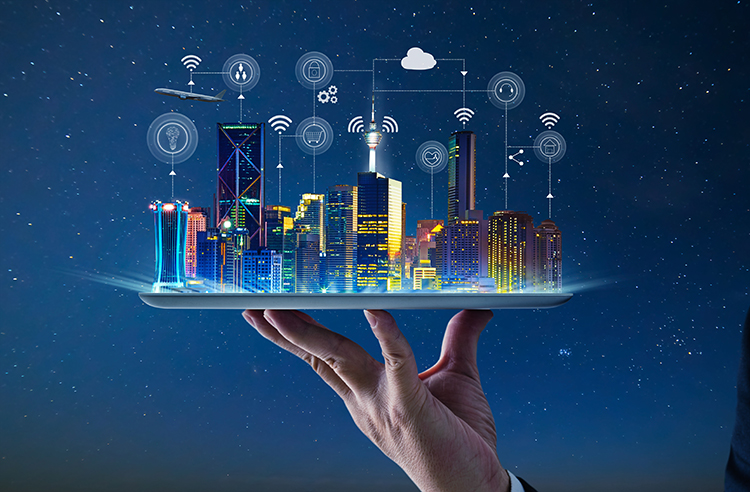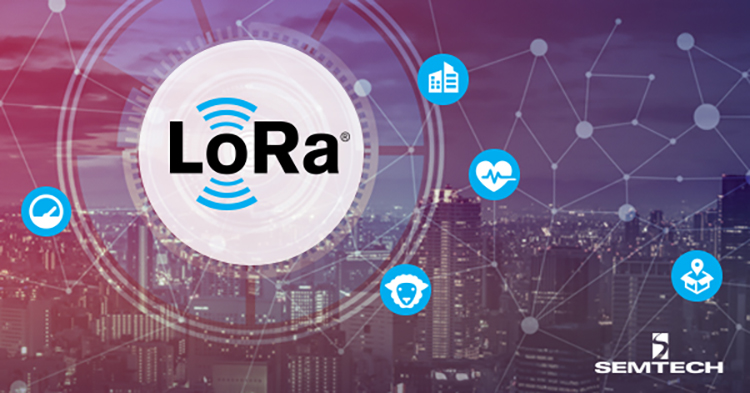LoRa technology driving the global use of IoT
All around us our environment is being influenced, altered and managed by the ever-increasing adoption of IoT solutions. This technology has enabled major advances to be made in the rapid sharing of accurate data which in turn has been boosting efficiency levels for organisations from small businesses to large cities. Marc Pegulu. Vice President, Wireless LoRa and IoT at Semtech explains the role LoRa technology is playing.
The versatility of IoT technology has seen it adopted in a wide range of industries and applications across the world. These include the development of intelligent buildings (such as apartment blocks, offices, hospitals and medical care facilities, factories and warehouses) which form the backbone of today’s smart cities and communities. Other applications include intelligent supply chains and logistics, smart agriculture, intelligent metering and smart industrial control.
For the end user, IoT networks work behind the scenes and the influence they have is not always immediately obvious. However, for those tasked with creating highly efficient data communications systems that can deliver up-to-date information where it is needed and when it is needed, IoT is at the very core of what they do.
Leading the global adoption of IoT systems is long-range (LoRa) wireless technology which operates across low-power wide area networks (LPWANs). Because the technology has minimal power requirements, around 1,000 LoRa-based sensors can pair with a single gateway and that takes the collection and sharing of real-time data to a whole new level. LoRa has proved to be so successful that to date it is being used in more than 100 countries with more and more cities announcing they are adding LoRaWAN-based networks every month.
The COVID-19 factor
While IoT has been around for many years in its various stages of development and usage, the advent of the COVID-19 pandemic has given the technology even greater relevance because now, more than ever, highly accurate data needs to be acquired and shared around the globe with minimal delay. It is no exaggeration to say that the ability for communities and healthcare providers to have access to such data can have life or death implications.
In the battle against the coronavirus, LoRa devices and the LoRaWAN protocol are helping governments and businesses to implement such vital IoT-based systems as end-to-end tracking – including contact tracing, proximity monitoring, geofencing and quarantine management. Other applications where LoRa devices are playing a key role include infrared temperature measurement, air quality monitoring, footfall monitoring and building occupancy. The ability to gather accurate data relating to these activities has been recognised as being vital as sectors such as retail, hospitality and aviation gradually move out of lockdown.
In one application related specifically to the current focus on public safety, Polysense has used LoRa technology to develop smart human body temperature monitoring products that allow healthcare workers in Italy and elsewhere to screen people using infrared sensors. Thanks to these LoRa devices, officials have access to real-time data that enables them to make instant healthcare decisions. Polysense’s customers operate in airports, schools, public transport, railway stations, shopping centres and large buildings. They are using Semtech’s WxS x800-IRTM wireless sensor alongside embedded LoRa devices to monitor people’s temperatures and feed that data swiftly via LoRaWAN to cloud-based applications. People whose temperatures exceed agreed thresholds are sent alerts so that they can take appropriate action.
Reliability, security and scalability
However, while the pandemic has recently underlined the benefits of adopting LoRa technology, its three main features of reliability, security and scalability have meant that it finds applications in any area where other communications technologies – such as Bluetooth, Wi-Fi and 5G – have proven to be inadequate.
For example, LoRa is highly suitable for asset tracking because it combines long-range capabilities with minimal power usage thanks to sensors operating on batteries that can last up to ten years. Data security is delivered through end-to-end encryption which defends against breaches and malicious attacks by ensuring every connected device has a valid 128-bit AES key and identifier. Finally, scalability is achieved by LoRa devices being upwardly compatible with next generation IoT solutions, making the technology ideal for creating future IoT-based network designs in a variety of highly demanding industries.

These features have been taken on board by Microshare – a data leverage platform for IoT – which has used LoRa technology to develop its Clean=Safe range of smart facilities solutions. The range is proving highly popular among organisations tasked with managing the health and safety of staff, customers and tenants who use their facilities.
Ideal for infection control, predictive cleaning, occupancy and asset zoning, Clean=Safe uses badges, wristbands, keyrings and other wearable devices to gather data. This enables LoRa devices to make it possible to gauge the health of a building’s occupants, improve cleanliness and enhance the management of rooms, desks and beds. At the same time, real-time monitoring of facilities through LoRa technology helps to reduce expenditure on heating and air conditioning while boosting customer satisfaction.
Designed to make it easy for facilities operators to respond quickly to problems, Microshare’s solutions use QR codes so that anonymised reporting and feedback are possible. Also, because the system runs on LoRaWAN gateways that operate separately from proprietary networks, there are none of the security problems that Wi-Fi and other cellular technologies are susceptible to.
Restaurants, retail, assets and pollution
In a recent announcement, LoRa-based technology has been embraced by Deutsche Telekom to help retail outlets in Germany – particularly restaurant chains – manage their in-store traffic volumes. Located at store entrances, the sensor-based technology regulates access via a ‘traffic light’ system, using LoRaWAN or the 4G mobile communications standard LTE for local area sensor connectivity. For example, staff are notified via an app if someone enters a store when a red light is showing. At the same time, LoRaWAN, LTE, WiFi or Ethernet are used for gateway connectivity to the cloud for handling analytics and historical data.
Indeed, these LoRa-based systems are being used widely by retailers in Germany to monitor and analyse footfall by time of day and day of week. This enables retailers to plan more accurately how many staff are needed on-site or what the most convenient time is to carry out such activities as cleaning or stock replenishment.
For geolocation and asset tracking, Semtech’s recently developed LoRa Edge platform has helped to cut the cost of locating and monitoring IoT assets while also simplifying the process. LoRa Edge is a software-defined platform that has been designed specifically for indoor and outdoor asset management applications.

In outdoor scenarios transceivers use GPS satellite tracking, while indoors they use Wi-Fi passive scanning. LoRa Edge combines the two technologies to enable outdoor-to-indoor tracking, ideal when assets are being transported from one location to another or move from transporter to warehouse, for example. For valuable assets used indoors, including expensive medical equipment, construction tools or high-price retail goods, LoRa Edge transceivers can locate and track an item for many years, switching automatically to GPS scanning should an asset subsequently leave the building for any reason.
LoRa has also boosted IoT connectivity in Glasgow with the installation of a gateway at the City of Glasgow College’s new Riverside Campus, bringing the total number of gateways in the city to nine. To date, the network has enabled authorities to monitor pollution levels in the city while also overseeing river levels and even capacity levels in refuse bins. Capable of connecting as many as 10,000 devices in a busy urban area, the latest gateway was created by Semtech working in conjunction with Stream Technologies, Boston Networks and the Scottish innovation Centre for Sensor and Imaging Systems (Censis).
In summary
It is as though IoT technology is coming of age and there are many reasons that LoRa-based networks are increasingly becoming the first choice for design engineers responsible for developing a host of cutting-edge IoT applications. Reliability, security and scalability are important, of course, but equally attractive is the technology’s ability to operate over distances of up to 20km using a fraction of the power that other platforms need. These features make LoRa ideal for bi-directional data transmission across smart buildings, smart cities and even between countries, and they will enable IoT to play an increasingly influential role in the lives of virtually everybody on the planet.






